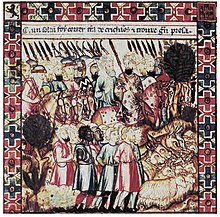
Back صقالبة (الأندلس) Arabic Сакалиби Bulgarian Saqaliba Catalan Saqāliba German Saqaliba Spanish Saqaliba French Saqaliba Italian サカーリバ Japanese 사칼리바 Korean Saqaliba Dutch
| Part of a series on |
| Slavery |
|---|
 |



Saqaliba (Arabic: صقالبة, romanized: ṣaqāliba, singular Arabic: صقلبي, romanized: ṣaqlabī)[nb 1] is a term used in medieval Arabic sources to refer to Slavs, and other peoples of Central, Southern, and Eastern Europe. The term originates from the Middle Greek slavos/sklavenos (Slav), which in Hispano-Arabic came to designate first Slavic slaves and then, similarly to the semantic development of the term in other West-European languages, foreign slaves in general.[2]
The word was often used to refer specifically to Slavic slaves, but it could also refer more broadly to Central, Southern, and Eastern Europeans traded by the Arab traders, as well as all European slaves in some Muslim regions like Spain and Portugal including those abducted from raids on Christian kingdoms of Spain and Portugal.[3][4] According to Sudár and B. Szabó, the word Saqaliba means 'forest dweller', regardless of ethnicity.[5]
There were several major routes for the trading of Slavic slaves into the Arab world: through Central Asia (Mongols, Tatars, Khazars, etc.) for the East Slavs; through the Balkans for the South Slavs; through Central and Western Europe for the West Slavs and to al-Andalus.[citation needed] The Volga trade route and other European routes, according to Ibrahim ibn Jakub (10th century), were serviced by Radanite Jewish merchants. (Compare Crimean–Nogai raids into East Slavic lands.) Theophanes mentions that the Umayyad caliph Mu'awiya I settled a whole army of 5,000 Slavic mercenaries in Syria in the 660s.[citation needed] After the battle of Sebastopolis in 692, Neboulos, archon of the Slavic corps in the Byzantine army, and 30,000 of his men were settled by the Umayyads in the region of Syria.[6][7]
In the Arab world, the Saqaliba served or were forced to serve in a multitude of ways: as servants, harem concubines, eunuchs, craftsmen, mercenaries, slave soldiers, and as Caliph's guards. In Iberia, Morocco, Damascus and Sicily, their military role may be compared with that of mamluks in the Ottoman Empire. In al-Andalus, Slavic eunuchs were so popular and widely distributed that they became synonymous with the term Saqāliba, though not all Saqaliba were eunuchs.[8][9] Some Saqāliba became rulers of taifas (principalities) in Iberia after the collapse of the Caliphate of Cordoba in 1031. For example, Mujāhid al-ʿĀmirī organized the Saqaliba in Dénia to rebel, seize control of the city, and establish the Taifa of Dénia (1010–1227), which extended its reach as far as the island of Majorca.
- ^ A. P. Vlasto; Vlasto (2 October 1970). The Entry of the Slavs Into Christendom: An Introduction to the Medieval History of the Slavs. CUP Archive. p. 320. ISBN 978-0-521-07459-9.
- ^ Golden, P.B.; Bosworth, C.E.; Guichard, P.; Meouak, Mohamed (1995). "al- Ṣaḳāliba". In P. Bearman; Th. Bianquis; C.E. Bosworth; E. van Donzel; W.P. Heinrichs (eds.). Encyclopaedia of Islam. Vol. 8 (2nd ed.). Brill. p. 872. doi:10.1163/1573-3912_islam_COM_0978.
- ^ Mishin 1998.
- ^ Historical Encyclopedia of World Slavery saqaliba&f=false The Historical Encyclopedia of World Slavery: A-K ; Vol. II, L-Z, by Junius P. Rodriguez
- ^ Sudár Balázs, B. Szabó János. Dentumoger II. - Tanulmányok a korai magyar történelemből – Gyula népe - Madzsgarok a 10. századi muszlim földrajzi irodalomban (2022). ISBN 9789634163039 pp. 136
- ^ Treadgold, Warren T. (October 1997). A History of the Byzantine State and Society. Stanford University Press. ISBN 978-0-8047-2630-6.
- ^ Lilie, Ralph-Johannes. Prosopographie der mittelbyzantinischen Zeit: 1. Abteilung (641–867), Band 3: Leon (# 4271) – Placentius (# 6265). Berlin and Boston: De Gruyter. ISBN 978-3-11-016673-6.
- ^ The Historical Encyclopedia of World Slavery: A-K; Vol. II, L-Z, by Junius P. Rodriguez
- ^ Lev, Yaacov (1991). State and Society in Fatimid Egypt. BRILL. pp. 74, 77–78. ISBN 978-90-04-09344-7.
Cite error: There are <ref group=nb> tags on this page, but the references will not show without a {{reflist|group=nb}} template (see the help page).
© MMXXIII Rich X Search. We shall prevail. All rights reserved. Rich X Search